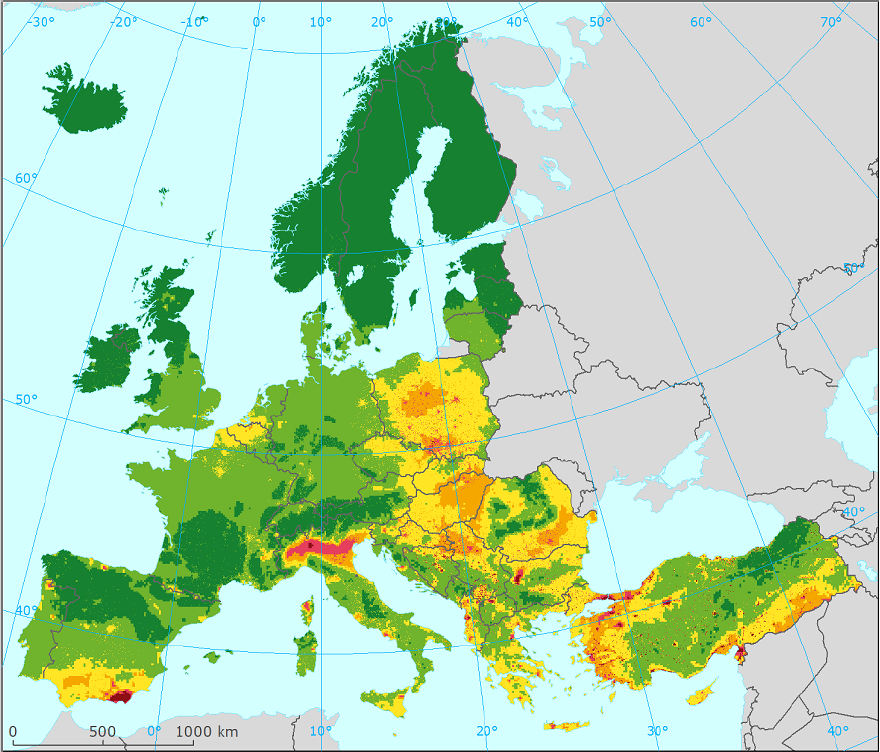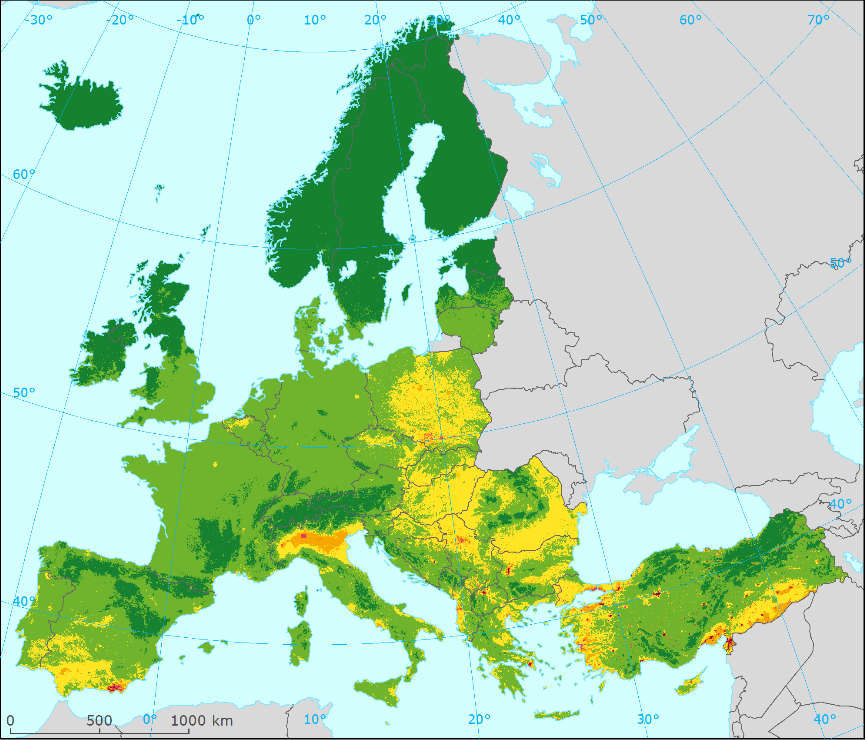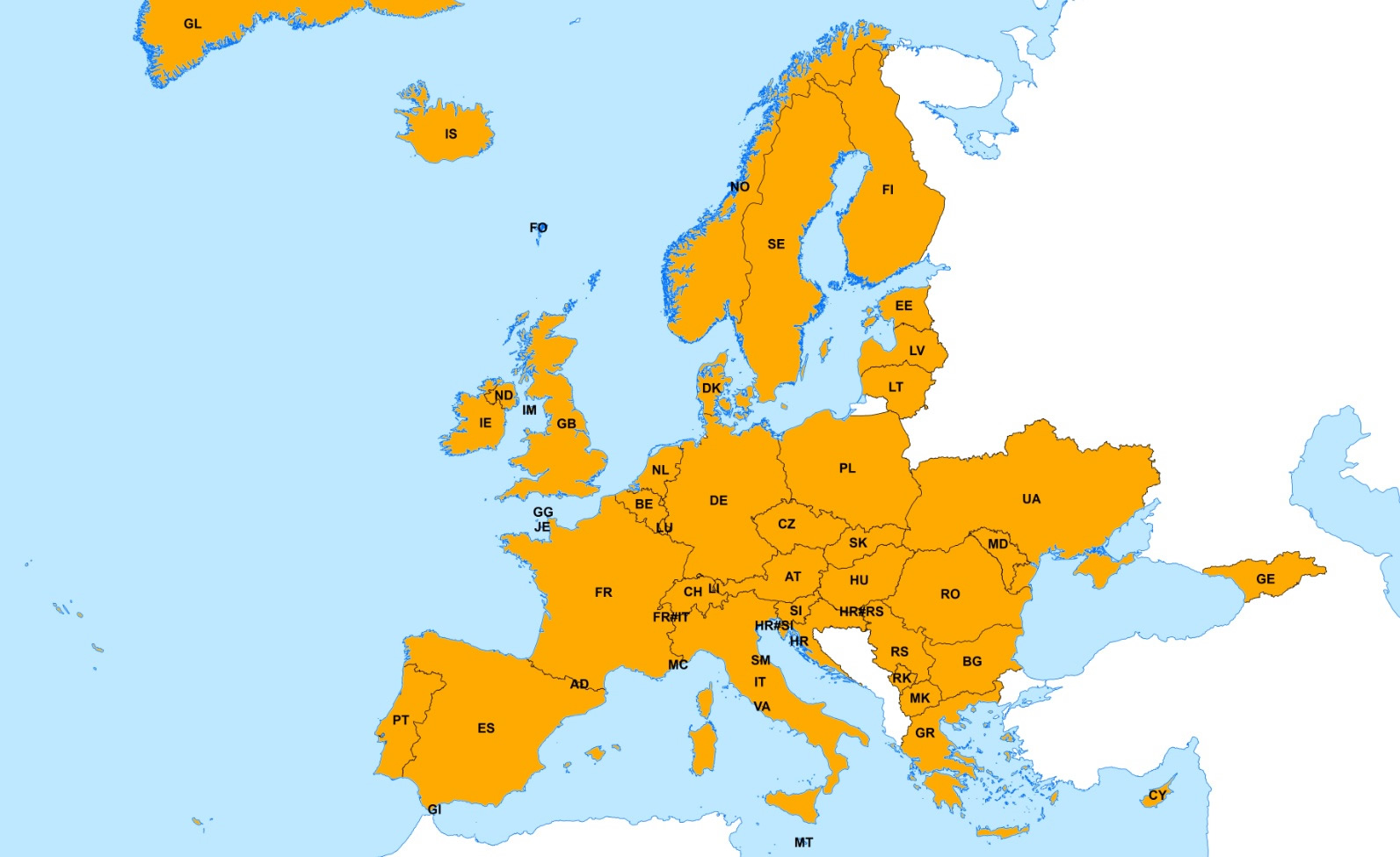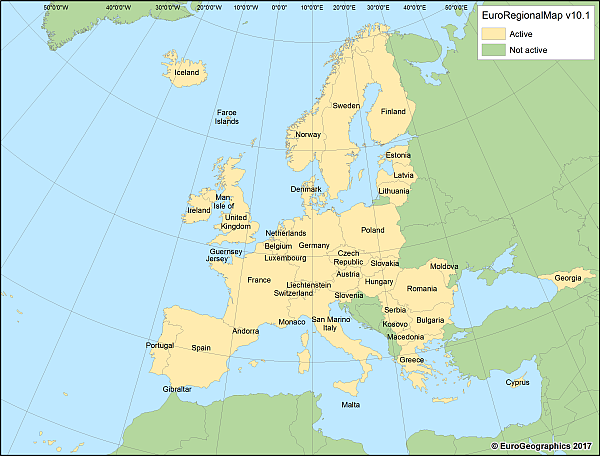San Marino
Type of resources
Available actions
Topics
INSPIRE themes
Keywords
Contact for the resource
Provided by
Years
Formats
Representation types
Update frequencies
status
Scale
Resolution
-

The delineation of European mountain areas was carried out by using digital elevation models, considering different criteria combination of thresholds of altitude, climate, and topography variables (IP2008 8.2.7 Regional and territorial development of mountain areas, ETC/LUSI - EEA). This dataset was created in 2008, covers the full European continent and is a reference layer for the EEA Report No 6/2010 on Europe's ecological backbone: recognising the true value of our mountain (https://www.eea.europa.eu/publications/europes-ecological-backbone).
-

An urban morphological zone (UMZ) is defined as a "set of urban areas laying less than 200 m apart". This layer contains UMZ delineations for Europe, based on Corine Land Cover database. During 2012, the UMZ methodology was updated in order to correct errors derived for the water course as join elements between urban areas. Previous version applied over CLC v15 (and previous version) joined many small urban areas due to the water presence. This fact was erroneous from the landscape and urban perspective as most of those areas remain as urban-rural typologies. Moreover, water courses cannot be considered as roads from the urban morphological view (either from the commuting point of understanding). This new version, known as v16, corrected this effect in the majority of cases.
-

The data set provides the EEA 1 km and 2 km grids combining the monitoring air quality data in a ‘regression-interpolation-merging mapping’ methodology and the observational values of the air quality monitoring stations used in the interpolation. The full data set covers Europe for the year 2016, and in particular for the pollutants PM10, PM2.5, O3, NO2 and NOx. This data set is used to estimate population and vegetation exposure to air pollution, as an input to the indicator CSI005 (Exposure of Europe's ecosystems to acidification, eutrophication and ozone) and for the health impact assessments published in the Air Quality in Europe reports. The methodology and the maps themselves can be found in the 2018 Eionet report "European air quality maps for 2016" at https://www.eionet.europa.eu/etcs/etc-atni/products/etc-atni-reports/etc-acm-report-2018-8-european-air-quality-maps-for-2016. The data set for download also includes the maps in TIFF format present in the reports.
-

The data set provides the EEA 1 km and 2 km grids combining the monitoring air quality data in a ‘regression-interpolation-merging mapping’ methodology and the observational values of the air quality monitoring stations used in the interpolation. It covers Europe for the year 2017 and for the pollutants PM10, PM2.5, O3, NO2 and NOx. It includes SOMO10, as a novelty from the 2016 data set. This data set is used to estimate population and vegetation exposure to air pollution, as an input to the indicator CSI005 (Exposure of Europe's ecosystems to acidification, eutrophication and ozone) and for the health impact assessments published in the Air Quality in Europe reports. The methodology and the maps themselves can be found in the 2019 Eionet report "European air quality maps for 2017" available at https://www.eionet.europa.eu/etcs/etc-atni/products/etc-atni-reports/etc-atni-report-9-2019-european-air-quality-maps-for-2017-pm10-pm2-5-ozone-no2-and-nox-spatial-estimates-and-their-uncertainties. The data set for download also includes the maps in TIFF and PNG format included in the reports.
-

EuroBoundaryMap provides a European geographic database for administrative and statistical regions that will be maintained at the source level by the National Mapping and Cadastral Agencies (NMCAs), and by providing harmonized access conditions for this geographic information within the framework of EuroGeographics. EBM (1:100000) offers the combined strength of detailed European administrative units and linkages to the corresponding LAU and NUTS codes. This metadata refers to the version 2020 of EBM, which is a complete new update of the EBM product based on the new NUTS2016 regulation. The basis for the update was the previous release EBM 2019. The dataset is provided both in a full Europe dataset (Data_FullEurope) and divided by countries (Data_Countries) in GDB format. EBM 2020 contains the matching with the NUTS regulations No 2016/2066 (NUTS 2016) and refers to the administrative situation as it was in each country on 31 January 2018 (reference date). Names of administrative units and levels are stored with Unicode character set as well as standard ASCII. Considering the user requirements, it can also be distinguished between land and water parts of administrative units within EuroBoundaryMap.Territorial sea areas are included for a number of countries as an optional feature. This comprises territorial waters assigned to administrative units on lowest national level as well as territorial waters, which are directly administered by the national government. The definition of the territorial sea strictly follows the United Nations Convention on the Law of the Sea. All territorial sea areas are attributed as coastal waters. For more information about the data product specifications and changes with respect to the previous version of this dataset (EBM 2019), please refer to the documents EBM_2020_Specification.pdf and EBM_2020_Changes.pdf provided with the data set under the folder "Documents" and "Descriptions_Metadata" under "Documentation" link. The EBM Full Europe database ("EuroBoundaryMap_2020") does not contain either Kosovo (KS) as independent country or Serbia (RS) including Kosovo following Serbian legal position). "EuroBoundaryMap_2020_optionRS" includes only the individual data set of Serbia with Kosovo following Serbian legal position. "EuroBoundaryMap_2020_optionKS" includes only the individual data sets of Serbia and Kosovo, the latter as independent country. It is advised to use the code XK instead of KS for Kosovo. IMPORTANT NOTE: This data set is only to be used internally in the EEA, for the purposes and under the conditions stated under the "Resource Constraints" elements of this metadata file and on the document "LicenseConditions_EBM.pdf" provided with this dataset under "Documentation" link. This metadata has been slightly adapted from the original metadata file provided by EuroGeographics and is to be used only for internal EEA purposes. For reference, the metadata file created by EuroGeographics is provided together with the dataset ("Metadata_EBM_2020.xml" within the "Descriptions_Metadata") as well as the national metadata stored under each corresponding country folder in "Descriptions_Metadata" provided together with the dataset under the link "Documentation".
-

An urban morphological zone (UMZ) is defined as a "set of urban areas laying less than 200 m apart". This layer contains UMZ delineations for Europe, based on Corine Land Cover database. During 2012, the UMZ methodology was updated in order to correct errors derived for the water course as join elements between urban areas. Previous version applied over CLC v15 (and previous version) joined many small urban areas due to the water presence. This fact was erroneous from the landscape and urban perspective as most of those areas remain as urban-rural typologies. Moreover, water courses cannot be considered as roads from the urban morphological view (either from the commuting point of understanding). This new version, known as v16, corrected this effect in the majority of cases.
-

The data set provides the EEA 1 km and 2 km grids combining the monitoring air quality data in a ‘regression-interpolation-merging mapping’ methodology and the observational values of the air quality monitoring stations used in the interpolation. The full data set covers Europe for the year 2016, and in particular for the pollutants PM10, PM2.5, O3, NO2 and NOx. This data set is used to estimate population and vegetation exposure to air pollution, as an input to the indicator CSI005 (Exposure of Europe's ecosystems to acidification, eutrophication and ozone) and for the health impact assessments published in the Air Quality in Europe reports. The methodology and the maps themselves can be found in the 2018 Eionet report "European air quality maps for 2016" at https://www.eionet.europa.eu/etcs/etc-atni/products/etc-atni-reports/etc-acm-report-2018-8-european-air-quality-maps-for-2016. The data set for download also includes the maps in TIFF format present in the reports.
-

The data set provides the EEA 1 km and 2 km grids combining the monitoring air quality data in a ‘regression-interpolation-merging mapping’ methodology and the observational values of the air quality monitoring stations used in the interpolation. It covers Europe for the year 2018. It provides estimates for human health related indicators of pollutants PM10 (annual average, 90.4 percentile of daily means), PM2.5 (annual average), ozone (93.2 percentile of maximum daily 8-hour means, SOMO35, SOMO10) and NO2 (annual average), and vegetation related ozone indicators (AOT40 for vegetation and for forests) for the year 2018. The data set contains also Phytotoxic ozone dose (POD) for wheat and potato and NOx annual average grids for 2018. The POD data set is presented for the first time. This data set is used to estimate population and vegetation exposure to air pollution, as an input to the indicator CSI005 (Exposure of Europe's ecosystems to ozone) and for the health impact assessments published in the Air Quality in Europe reports. The methodology and the corresponding maps can be found in the 2020 Eionet report "European air quality maps for 2018. PM10, PM2.5, Ozone, NO2 and NOx Spatial estimates and their uncertainties" (ETC/ATNI Report 10/20) available at https://www.eionet.europa.eu/etcs/etc-atni/products/etc-atni-reports/etc-atni-report-10-2020-european-air-quality-maps-for-2018-pm10-pm2-5-ozone-no2-and-nox-spatial-estimates-and-their-uncertainties-1. This data set includes the station values and the gridded interpolated values in Shapefile format and the interpolated values in OVR and GeoTIFF formats. It can also be downloaded in Spatialite-Rasterlite. For convenience, the data set also includes the maps in TIFF and PNG format included in the report.
-

EuroGlobalMap is a topographic dataset that covers the EU, Andorra, Croatia, Faroe Islands, Georgia, Greenland, Iceland, Kosovo, Liechtenstein, North Macedonia, Moldova, Monaco, Norway, San Marino, Serbia, Switzerland, Ukraine and Vatican at the scale 1:1 Million. It is produced in cooperation by the National Mapping Agencies of Europe, using official national databases. Thematic layers: Administrative Boundaries, Water network, Transport Network, Settlements and Named Locations. This metadata refers to the version 10 of EGM of full Europe. For more information about the data product specifications and changes with respect to the previous version of this dataset (EGM v9), please refer to the documents EGM_Specification_v10.pdf, EGM_UserGuide_v10.pdf and EGM_Changes_v10.pdf provided with the dataset (DOCUMENTS.zip). This metadata has been slightly adapted from the original metadata file provided by EuroGeographics and is to be used only for internal EEA purposes. For reference, the metadata file created by EuroGeographics is provided together with the dataset ("EGM_v10_Metadata.xsl" within the "METADATA.zip")
-

EuroRegionalMap is a Pan-European topographic vector dataset at scale 1: 250000, that is seamless and harmonized across boundaries. It is produced in cooperation by the National Mapping Agencies of the participating countries using official national databases. Thematic layers: Administrative Boundaries Hydrography Miscellaneous Named Location Settlement Transportation Vegetation and Soil Points of Interests
 RUC Geo-Data catalogue
RUC Geo-Data catalogue